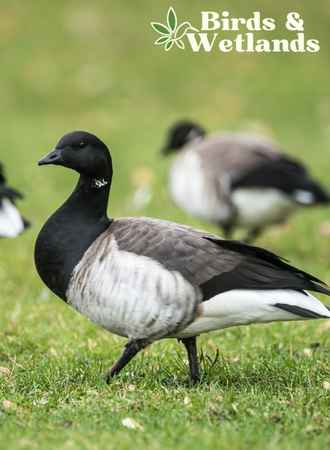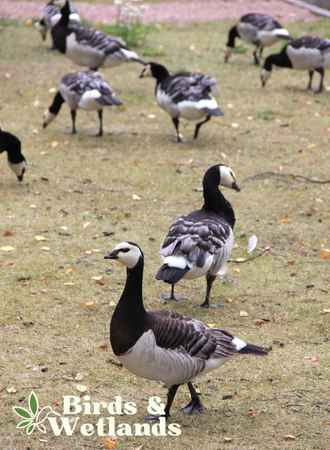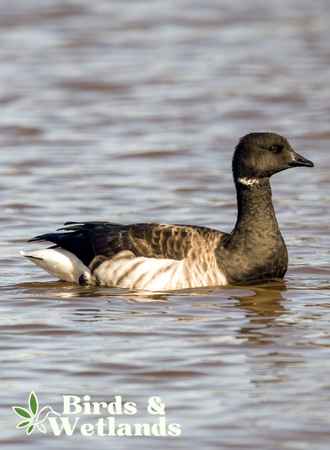The brant, also known as the brent goose, is a small goose best known for its long migration each winter, in which large flocks of brant geese travel from their Arctic breeding grounds down to temperate shorelines and coastal wetlands, where they feed on eelgrass and other aquatic plants.
Scientific Name: Branta bernicla
Height: 55–66 cm (22–26 in)
Wingspan: 106–121 cm (42–48 in)
Weight: 0.88–2.2 kg (1.9–4.9 lb)
Description
The brant goose is known for its distinctive appearance. With a short, stubby bill, black head, dark brown upperparts, brown-barred and pale gray underparts. The undertail is pure white and the tail black.
There are three subspecies of brant:

Dark-bellied brant (B. b. bernicla)
The Dark-bellied brant goose has a similar appearance and size to the other two brant subspecies but has a darker gray belly.
Pale-bellied brant (B. b. hrota)
This subspecies is also known as light-bellied brent goose in Europe, and Atlantic brant or gray-bellied brant in North America.
The Atlantic brant is a compact goose with a distinctive appearance. Its black neck sock and brownish back make it easy to identify, as do its pale underparts.

Black brant (B. b. nigricans)
The Black Brant has a short bill, a partial white ring, and extensive dark markings on the belly. It stands out from other waterfowl due to the low contrast between its chest and belly. This bird is also known as the “Pacific Brant”, making it easy to identify by anyone who has seen it before.
Listen to Brant
Habitat
Brant is a uniquely adapted species that thrive in various habitats. During the summer months, these birds prefer coastal tundra habitats and coastal islands, where they can find plenty of open areas with shallow water and access their preferred food sources. In the winter, brant geese migrate to mild regions along coastlines, where they typically inhabit salt marshes and estuaries.
Depending on the region and the time of year, these geese may also stop at inland freshwater lakes for rest or refueling during their migration.

Range

The brant has a relatively broad geographic range, breeding in coastal Alaska and the Canadian Arctic and wintering along the Pacific coasts south to California and the Carolinas. The population range of the brant varies depending on the season; during the mating season, it can be found in the high Arctic, northwestern Canada and Canada’s northern areas and coastal regions.
The Pacific subspecies spends winters along the west coast from British Columbia to Baja California. These flocks use the Izembek Lagoon and Puget Sound as major stopovers. While other flocks winter in Skagit County in Washington and wintering grounds are found in Southern British Columbia and the east side of Hudson bay.
Brants of Europe winter in western Europe.
During migration, most geese fly in unorganized flocks. They don’t fly in V formation like the Canada geese or in a straight line like the snow geese.
Diet
Brants feed primarily on plant matter including algae, seaweed, sea lettuce and other forms of aquatic vegetation. In addition to feeding in these rich marine habitats, many brants also graze on farm fields and golf courses often with other species such as Canada geese during the non-nesting season. They also drink salt water, thanks to a highly developed salt gland.
Nesting & Mating
The nesting habits of the brant goose are characterized by a few key behaviors that help the species survive in its natural environment. Upon entering the mating season, which typically lasts from June to mid-August, brant geese form pairs or loose colonies and retreat to the tundra or sheltered bays near water sources in the high Arctic. There, they build a shallow bowl on the ground lined with fine materials such as grass, moss, and down.
The female brant goose typically lays 3–5 eggs and then incubates them for 24–26 days while the male remains close to their nest. When the female leaves the nest to forage for food, she wraps down around the eggs to keep them warm. Their young feed at all hours.

Population & Conservation
The world population estimates for this species range from 600,000 to over 1.5 million individuals, indicating that it remains relatively abundant despite past declines.
Over recent decades, this species’s conservation status has fluctuated considerably due to changes in breeding and migratory habitats.
Habitat degradation due to human activities such as mining and pollution has impacted the brant’s breeding grounds on American coastlines.
Its current conservation status is considered Least Concern.
Hunting
It is widely accepted that brant geese are some of the most prized birds to hunt in the United States. These waterfowl typically flock along the coastlines, making them a popular target for hunters in those coastal regions. In many states, the daily limit for hunting brant geese is typically two birds per day or four in possession, although this can vary from state to state and the U.S Fish and Wildlife Service.

Key Points
The brant is a small, attractive waterfowl species that looks a lot like a Canada goose.
There are three subspecies of brant: dark-bellied, pale-bellied, and black brant.
These geese primarily feed on plant matter, grazing on aquatic vegetation during the breeding season and land vegetation during the non-breeding season in their preferred habitats.
Brants spend winters along the Pacific Coast to mainland Mexico, and along the Atlantic coast in the east.

